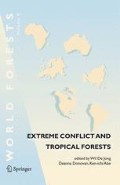Abstract
The end the Cold War has not brought violent conflict to an end. Thewar in Afghanistan, the war in Iraq, as well as recent events in New York, London, Madrid and Bali suggest that the danger of potential destructive wars remains high. Civil wars or other smaller scale conflicts continue in many African countries, killing and displacing vast amounts of people from the Sudan to the Congo. Drug cartels continue to wreak havoc in countries in South America. Similar examples can be given from Cambodia, Myanmar, Philippines, Indonesia, Nepal and Sri Lanka. These are examples of conflict that affect societies at large in many tropical forest countries. Because of modern means of communication, increasing demand on resources driven by higher consumption levels and larger number of people, and the spread of modern instruments of war, future wars are likely to be extremely destructive for both people and nature.
Access this chapter
Tax calculation will be finalised at checkout
Purchases are for personal use only
Preview
Unable to display preview. Download preview PDF.
REFERENCES
Abdulla, R. (1997). Protected areas during and after conflict. Nimule National Park: A case study. In IUCN (Ed.), Parks for Peace Conference Proceedings (pp. 195–199). Gland, Switzerland: IUCN.
Brock, L. (1991). Peace through parks: The environment on the peace research agenda. Journal of Peace Research, 28(4), 407–423.
Crosby, A. (1986). Ecological Imperialism. New York: Cambridge University Press.
Dillon, T. C., & Wikramanayake, E. D. (1997). Parks, peace and progress: A forum for transboundary conservation in Indo-China. PARKS, 7(3), 36–51.
Edgerton, R. B. (1992). Sick Societies: Challenging the Myth of Primitive Harmony. New York: The Free Press.
Ember, C. R., & Ember, M. (1992). Resource unpredictability, mistrust, and war. Journal of Conflict Resolution, 36(2), 242–262.
Fairhead, J., & Leach, M. (1995). False forest history, complicit social analysis: Rethinking some West African environmental narratives. World Development, 23(6), 1023–1035.
Ferguson, R. B. (1989). Ecological consequences of Amazonian warfare. Ethnology, 28, 249–264.
Flannery, T. (1994). The Future Eaters: An Ecological History of the Australasian Lands and People. New York: George Braziller.
Hanks, J. (1998). Protected areas during and after conflict: The objectives and activities of the peace parks foundation. PARKS, 7(3), 11–24.
Harbinson, R. (1992). Burma’s forests fall victim to war. The Ecologist, 22(2), 72–73.
Hart, T. B., & Hart, J. A. (1997). Zaire: New models for an emerging state. Conservation Biology, 11(2), 308–309.
Heider, K. (1970). The Dugum Dani: A Papuan Culture in the Highlands of West New Guinea. Chicago: Aldine.
Hill, J. D. (1994). Alienated targets: Military discourse and the disempowerment of indigenous Amazonian peoples in Venezuela. Identities, 1(1), 7–34.
Homer-Dixon, T. F. (1994). Environmental scarcities and violent conflict: Evidence from cases. International Security 19(1), 5–40.
Kane, H. (1995). The hour of departure: Forces that create refugees and migrants. WorldWatch Paper, 125, 1–56.
Keeley, L. H. (1996). War Before Civilization. New York: Oxford University Press.
Knauft, B. M. (1990). Melanesian warfare: A theoretical history. Oceania, 60, 250–311.
Lee, K. N. (1993). Compass and Gyroscope: Integrating Science and Politics for the Environment. Washington, DC: Island Press.
Martin, P. S., & Klein, R. G. (Eds.) (1984). Quaternary Extinctions: A Prehistoric Revolution. Tucson: University of Arizona Press.
McClure, H. E. (1974). Migration and Survival of the Birds of Asia. Bangkok: US Army Component, SEATO Medical Research Laboratory.
McNeely, J. A. (1994). Lessons from the past: Forests and biodiversity. Biodiversity and Conservation, 3, 3–20.
McNeely, J. A., & Wachtel, P. S. (1988). Soul of the Tiger: Searching for Nature’s Answers in Southeast Asia. Singapore: Oxford University Press.
Meggitt, M. (1977). Blood is their Argument: Warfare among the Mae Enga Tribesmen of the New Guinea Highlands. Palo Alto, CA: Mayfield.
Myers, N. (1979, Dec 8). Wildlife and the dogs of war. The Daily Telegraph, London.
Nietschmann, B. (1990). Battlefields of ashes and mud. Natural History, 11, 35–37.
Pearce, F. (1994, Dec 3). Soldiers lay waste to Africa’s oldest park. New Scientist p. 4.
Ponting, C. (1992). A Green History of the World: The Environment and the Collapse of Great Civilizations. New York: St. Martin’s Press.
Rappaport, R. A. (1984). Pigs for the Ancestors. Ritual in the Ecology of a New Guinea People. 2nd. ed., enlarged. New Haven, CT: Yale University Press.
Strada, G. (1996). The horror of land mines. Scientific American, 274(5), 26–31.
Thacher, P. (1984). Peril and opportunity: What it takes to make our choice. In J. A. McNeely & K. R. Miller (Eds.), National Parks, Conservation, and Development: The Role of Protected Areas in Sustaining Society (pp. 12–14). Washington, DC: Smithsonian Institution Press.
Thorsell, J. (Ed.) (1990). Parks on the Borderline: Experience in Transfrontier Conservation. Gland, Switzerland: IUCN.
Westing, A. H. (1976). Ecological Consequences of the Second Indo-China War. Stockholm: Almqvist and Wiksell.
Westing, A. H. (1982). The environmental aftermath of warfare in Vietnam. In World Armaments and Disarmament: SIPRI Year Book 1982, SIPRI (pp. 363–389). London: Taylor and Francis Ltd.
Westing, A. H. (1993). Transfrontier reserve for peace and nature on the Korean peninsula. In IUCN (Ed.), Parks for Peace Conference Proceedings (pp. 235–242). Gland, Switzerland: IUCN.
Westing, A. H. (1998). Establishment and management of transfrontier reserves for conflict prevention and confidence building. Environmental Conservation, 25(2), 91–94.
Zbicz, D. C., & Greene, M. (1998). Status of the world’s transfrontier protected areas. PARKS, 7(3), 5–10.
Editor information
Editors and Affiliations
Rights and permissions
Copyright information
© 2007 Springer
About this chapter
Cite this chapter
MCNEELY, J.A. (2007). ADDRESSING EXTREME CONFLICTS THROUGH PEACE PARKS. In: Jong, W.D., Donovan, D., Abe, KI. (eds) Extreme Conflict and Tropical Forests. WORLD FORESTS, vol 5. Springer, Dordrecht. https://doi.org/10.1007/978-1-4020-5462-4_10
Download citation
DOI: https://doi.org/10.1007/978-1-4020-5462-4_10
Publisher Name: Springer, Dordrecht
Print ISBN: 978-1-4020-5461-7
Online ISBN: 978-1-4020-5462-4
eBook Packages: Biomedical and Life SciencesBiomedical and Life Sciences (R0)

